This speech was part of the Southern People’s Action on COP26(SPAC26) event “From Grassroots Resistance towards Revolutionary Reconstruction: Visions from the Ground of the World We Want to Change”
10 November 2021
Omusober! Warm Greetings to all of you!
It’s a great honor for me to share the Karen People’s experience on Preserving Cultural and Ecological Integrity. Indigenous Karen People from Kawthoolei, South-Eastern Burma are custodians of one of the world’s largest remaining areas of contiguous tropical forest. Karen territories constitute a large part of the Dawna-Tenasserim Landscape, located in the Indo-Burma Biodiversity Hotspot.
The Challenges We Face
- Conflict, dispossession, and extractive development are tightly linked in Burma. Military plunder of Indigenous lands has led to mass deforestation, displacement of Indigenous communities, destruction of biodiversity.
- They have used both development and conservation as tools to expand its control over Indigenous territories for their own benefit. The military coup in Feb 2021 will create more of these problems in indigenous territories.
The Karen Response
- Karen communities have rejected military control and destructive resource extraction projects. Instead, they are working on strengthening grassroots governance models that uphold Indigenous self-determination and honour the sacred relationship between Indigenous Karen people and their lands. These initiatives, including the Thawthi Taw Oo Indigenous Park, the Salween Peace Park, and the Tanawthari Landscape of Life, exist in different political and geographical contexts but share many commonalities.
- Core to these models is the deep relationship between Karen communities and their lands, forests, and waterways. For our Karen people, everything is connected. Healthy nature directly corresponds to healthy communities and a healthy society.
- These models are also exemplary in terms of grassroots democracy and decision-making by and for Indigenous Peoples and Local Communities on a grand scale. Each local community is empowered to implement its own customary and Indigenous laws and adapt them based on changes in context, climate, and learning experiences from other communities.
- These models enable the elevation of customary law to landscape scale. In the Salween Peace Park, a Charter was developed collaboratively with Indigenous Elders and community representatives. It ensures that decisions uphold the collective well-being of all communities in the park and are based upon the collective will and vision of the park’s inhabitants.
- These models have also helped communities in bringing their voices and visions to the international community, for example by linking them to the global movement for Indigenous-declared protected areas, known as ICCAs or Territories of Life.

What do these Karen Models Mean in a Changing Burma?
- These models are an act of Indigenous resurgence. They empower Karen communities to revitalize their traditional practices, assert their rights, and manage their own natural resources. They are an enactment of inherent rights and responsibilities that flow from Karen people’s relationships with the land, each other, and more-than human beings, including the Htee K’Sah Kaw K’Sah, the spirit owners of the land and water.
- These models are also an act of sovereign refusal: they refuse a long history of colonial and military domination, including more than 100 years of British colonial rule and domination by successive military and civilian governments since the British left. They refuse unsustainable economic models driven by colonial legacy and refuse centralized and top-down conservation approaches that left out Indigenous Communities from decision making processes that trample on the rights and sacred responsibilities of Indigenous Peoples and Local Communities to their lands.
- Most importantly, these models are affirmation of Karen self-determination which means respect for Karen traditions and way of life, recognizing and respecting the value of Karen traditional resource governance system. For Karen, self-determination does not mean secession. It means respecting Karen communities as equal partners in a future Federal Democratic Burma.
- Karen communities have practiced conservation for generations, through waves of colonization, militarization, and centralization. Now, through these models, we offer our experience to the world. For Karen people, these models do not just offer a freedom from external domination, but also a freedom to act in solidarity for our collective future on this planet.
Recommendations for indigenous communities seeking to protect their land
- First, focus on strengthening the grassroots through building a resurgence movement rooted in the strength of your cultural traditions, identity, and relationship with your lands.
- Second, believe in yourself! Don’t wait for the government’s approval or permission. Instead, focus on developing a compelling, community-driven vision for the future you want, and then start living as if that vision were reality.
- Finally, build strategic alliances with those who will support your vision.
Conservation has the potential to become a tool for Indigenous liberation. But this can only happen if conservation sheds its colonial legacy and commits to upholding the sovereignty, governance, and leadership of Indigenous Peoples on their own ancestral territories.

